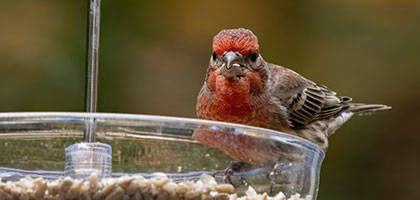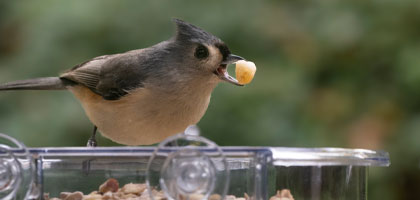Feeding cardinals can be a rewarding experience. These vibrant birds add color and life to any garden.
But what do cardinals eat? And how can you attract them to your yard year-round?
This guide will answer these questions. It will provide you with the ultimate guide to feeding cardinals throughout the year.
Whether you're a bird enthusiast or a homeowner looking to attract wildlife, this guide is for you. Let's dive in and learn how to keep these beautiful birds coming back to your garden all year long.
Understanding Cardinal Bird Diet Basics
Cardinals are non-migratory birds. They're found across North and South America. They have a diverse diet that changes with the seasons.
These birds favor seeds, which make up most of their diet. Black oil sunflower seeds are a staple for them. They are rich in fat and easy for cardinals to crack open.
Aside from seeds, cardinals eat fruits and insects. This variety provides essential nutrients that seeds alone cannot provide. Insects also offer much-needed protein, especially during the breeding season.
To meet these dietary needs, provide a variety of foods. Here’s a quick list of cardinal favorites:
- Sunflower seeds
- Safflower seeds
- Fresh fruits like apples and berries
- Mealworms
- Peanuts and other nuts
Understanding the cardinal bird diet is key to attracting them. A diverse food selection will keep them coming back. And don’t forget to maintain fresh food, as cardinals prefer fresh offerings.
Seasonal Feeding: What Cardinals Eat Throughout the Year
Cardinals' diets vary with the seasons. In spring and summer, they consume more insects. This diet change supports their energy needs during breeding.
In warmer months, cardinals also eat fruits and seeds. Apples, berries, and seeds like sunflower are ideal choices. These provide essential nutrients for active months.
As fall approaches, cardinals increase their fat intake. Sunflower seeds and nuts become more prominent in their diet. This helps them store energy for the cold months ahead.
Winter poses a challenge for cardinals. Finding food can be difficult. Offering suet cakes, pellets, or balls provides much-needed calories.
To keep cardinals well-fed, adjust the food offerings each season. Here’s a seasonal feeding guide to help:
- Spring/Summer: Insects, fresh fruits, sunflower seeds
- Fall: Increase in nuts and seeds for fat
- Winter: Suet products, sunflower seeds, nuts
By catering to their seasonal needs, you ensure cardinals remain healthy all year. Your efforts will attract them regularly, enhancing your bird-watching experience.
Choosing the Right Feeders for Cardinals
Selecting the right feeder is crucial for successfully attracting cardinals. Their size and feeding style should guide your choice. Cardinals prefer feeders that accommodate their larger size comfortably.
Cardinals are versatile when it comes to feeder types. Platform and hopper feeders are particularly suitable. Their design allows easy access for cardinals.
Consider placing feeders at different heights. This caters to their comfort and enhances your viewing experience. Cardinals typically feed from feeders placed at a medium height.
Location is key. Place feeders in quiet areas to minimize disturbance. Avoid spots with high foot traffic to keep cardinals at ease.
A variety of feeders can attract a diverse bird population. Beyond cardinals, you'll likely see finches, bluejays, and more. This enriches your garden with activity and color.
Here’s a quick list of feeder types suitable for cardinals:
- Platform Feeders
- Hopper Feeders
- Tube Feeders (for smaller seeds)
Large vs. Small Bird Feeders
Cardinals prefer feeders with ample space. Large feeders can accommodate multiple birds comfortably. Small feeders work but may limit access for cardinals.
Window, Suet, and Peanut Feeders
Window feeders offer close views of cardinals. They are perfect for intimate birdwatching. Suet feeders provide high-energy foods, especially in winter, while peanut feeders add variety.
Squirrel Proof and Raccoon Guards
Keeping pests at bay is important. Use squirrel-proof feeders to prevent food theft. Raccoon guards protect feeders, ensuring food is available for cardinals.
Best Foods to Offer Cardinals
Creating a diverse menu keeps cardinals healthy and happy. Understanding their dietary preferences can enhance your feeding strategy. Cardinals enjoy a mix of seeds, nuts, and insects.
Their strong beaks are well-suited to cracking seeds. Sunflower seeds, particularly black oil ones, are a favorite. Safflower seeds also appeal to cardinals and deter squirrels.
A varied diet attracts cardinals year-round. Fresh fruit and mealworms add nutrition and variety. Such offerings maintain their interest even as seasons change.
Offering high-energy foods during winter months is crucial. Suet pellets, cakes, and balls provide essential calories. They help cardinals maintain energy during cold spells.
Consistent feeding can turn your garden into a cardinal hotspot. A balanced diet invites them back daily. It can also attract other species like orioles and chickadees.
Here's a list of recommended foods for cardinals:
- Sunflower Seeds (black oil)
- Safflower Seeds
- Fresh Fruit (e.g., apple slices)
- Peanuts
- Mealworms
- Suet Pellets, Cakes, and Balls
Seeds and Mixes: Sunflower Hearts and More
Sunflower hearts offer high energy and are easy for cardinals to eat. Including a mix of seeds satisfies varying tastes. This diversity attracts and holds their attention.
Cardinals also appreciate seeds like safflower. These seeds are nutritious and often less appealing to pests. Combining seeds encourages cardinals to make regular visits.
Fresh Fruit and Mealworms
Fresh fruits like apples provide vitamins and hydration. They're especially favored in winter months. Mealworms, rich in protein, are excellent for breeding seasons.
Dried mealworms are convenient. They are easy to store and provide a reliable protein source. They're a year-round favorite among cardinals.
Suet Pellets, Cakes, and Balls
Suet products offer essential fats cardinals need during colder months. Pellets, cakes, or balls are easy to place in suet feeders. They supply energy necessary for warmth.
Homemade suet mixtures can cater to specific cardinal preferences. Add sunflower seeds or raisins for extra flavor. These treats ensure nutritious and appealing meals.
Maintaining a Cardinal-Friendly Environment
Creating a bird-friendly environment involves more than just food. Providing clean water and safe shelter is crucial for cardinals. These elements contribute to a holistic habitat.
Cardinals are attracted to areas with dense vegetation. Such settings offer them protection and nesting sites. A well-planned garden will keep them returning daily.
Regular maintenance of feeders and surrounding areas is vital. This prevents disease and ensures a welcoming space. Consistency in care makes your yard a cardinal paradise.
To nurture a cardinal-friendly environment, consider these elements:
- Clean water sources (birdbath or shallow pond)
- Dense shrubs and bushes for shelter
- Safe locations for feeders away from predators
- Consistently refilled and maintained feeders
Providing Water and Shelter
Fresh water is essential for drinking and bathing. Birdbaths offer a simple solution for cardinals' hydration needs. Regular cleaning of the water source is also important.
Safe shelter comes from planting shrubs and dense vegetation. These areas protect cardinals from predators and harsh weather. Offering shelter encourages them to nest nearby.
Planting Native Vegetation
Native plants provide natural food sources and nesting spots. Cardinals thrive in environments that mirror their natural habitats. Planting species native to your area aids their survival.
Native vegetation also attracts insects, which cardinals eat. This enhances the diversity of their diet. A rich environment ensures year-round cardinal visits.
Protecting Cardinals from Predators and Disease
Safety is a priority when attracting cardinals. Keep feeders away from hidden spots where cats may lurk. Elevated or isolated feeder placements can reduce predation risks.
Regularly clean feeders to prevent disease spread among bird populations. Hygiene is key to maintaining a healthy flock. Consistent cleaning practices can safeguard cardinals year-round.
Engaging with the Cardinal Community
Sharing your experiences can foster a sense of community among bird enthusiasts. Social media is a great place to share cardinal photos and tips.
Join local birdwatching groups to connect with fellow bird lovers. Participation in citizen science projects also contributes to the understanding of cardinal populations.
Conclusion: Commitment to Year-Round Cardinal Care
Feeding cardinals is a rewarding journey that requires attention and commitment. Consistent care ensures their health and continuous visits.
By offering diverse foods and a safe environment, you're cultivating a haven for these beautiful birds. Your dedication not only supports cardinals but enriches your local ecosystem.






